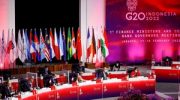Putin believed in the invincibility of his army and fell for this hook. What will he do next?

In the spring of 2018, four years before the invasion of Ukraine, Russian President Vladimir Putin gave an unusual speech about the growing strength of the Russian army. He boasted of a new hypersonic weapon designed to bypass US missile defense systems, noted Russia's successful intervention in the Syrian civil war, said that the size of Russia's conventional and nuclear arsenals had nearly quadrupled and that its armed forces had “significantly strengthened”. Putin also reiterated that Russia has the right to use nuclear weapons to defend its territories.
These comments exuded a strong sense of confidence in Russia's ability to successfully confront any adversary. “Nobody wanted to listen to us,” he warned, “So listen now.”
As Peter Clement writes in his article for Foreign Affairs, today, when the war in Ukraine is moving in an increasingly dangerous and unpredictable direction, the question of calculating Putin's risk has become acute. Since the beginning of September, Moscow has faced a series of setbacks. In response, Putin mobilized hundreds of thousands of additional troops, rushed to illegally annex territories that Russia does not fully control, and launched a new wave of missile strikes against mostly civilian targets, including Kyiv and other major cities. He has also repeatedly threatened to use nuclear weapons, noting that the US set such a precedent in Hiroshima and Nagasaki.
Also read: Putin has already lost, but what will he do next? Politico about possible scenarios of the development of events
Putin's threats of escalation have alarmed Russia's European neighbors, as well as the Biden administration. However, his willingness to rely on Russian military power did not begin in September, or even when he invaded Ukraine in February 2022. As the 2018 speech shows, his appetite for risk grew long before the current war.
Before Putin's invasion of Ukraine in 2022, he had built a reputation as a pragmatic risk-taker. During Russia's intervention in Georgia in 2008 and Crimea in 2014, Russian forces simply overwhelmed a smaller adversary; in Syria, Iran and Hezbollah did the heavy lifting on the ground, while Russia offered military hardware, air and sea power. In short, all three cases were relatively low risk, high payoff situations with limited casualties. So how to explain that he decided to attack Ukraine?
As you know, the main driving force behind the decision to launch a “special military operation” on February 24 was security problems, namely the fact that Ukraine seems to be slipping into NATO. But there was another impetus: Putin may have assessed that geopolitical circumstances offered a limited opportunity to decisively break out of the seven-year impasse in eastern Ukraine. In Moscow's view, the United States was politically polarized; the American public was mostly indifferent to Ukraine and wary of new foreign wars, especially after the messy US withdrawal from Afghanistan; the long-time chancellor of Germany, Angela Merkel, was leaving her post; the world was still concerned about the COVID-19 pandemic; and Europe was heavily dependent on Russian oil and gas. Finally, Putin became increasingly fascinated by Russian history and was determined to preserve his legacy as a great leader who restored Russia's core Slavic territories along with its rightful place as a world power.
Exactly when Putin decided to attack Ukraine remains a mystery, but by 2021, Russia was laying the military and political foundations for it. Throughout the year, Moscow has used planned military exercises to provide cover for a significant build-up of Russian forces along the Ukrainian border. Then, unscheduled military exercises with Belarus in mid-February 2022 put an additional 30,000 Russian troops on Ukraine's northern border – on a direct route to Kyiv.
Also read: WSJ: Winter will change the course of Russia's war against Ukraine
Observing the Kremlin's reaction to Ukraine's military successes in September-October, one remembers the ancient Chinese proverb: whoever rides a tiger is afraid to dismount. Eight months into a war that was supposed to end in days or weeks, Putin's invasion of Ukraine has turned into a disastrous quagmire that potentially threatens his rule. His response to Russia's mounting failures on the battlefield suggests he has few good options but to raise the stakes and take even more risks. So, the key question facing Ukraine and the West is how far Putin's escalation can go.
Russia will need to significantly replenish and expand its combat power if it hopes to advance on the battlefield, let alone conquer Ukraine. Putin's Aug. 25 decree to increase the size of the Russian army by 137,000 was the first sign of a manpower problem. But after Ukraine's achievements in early September, the problem of the lack of troops became acute, and on September 21, Putin announced a “partial mobilization.” This became a critical tipping point domestically, with an estimated 100,000 to 200,000 potential conscripts immediately seeking refuge abroad. Until September, the Russian military relied mainly on the recruitment and conscription of citizens from the more remote and ethnically diverse regions of the Russian Far East and North Caucasus. Now even Moscow and St. Petersburg are no longer protected from the realities of war.
Read also: Now is not the time to falter in the fight against Russian aggression – The Washington Post
In Russia itself, Putin will also have to weigh the impact of sanctions on the defense industry and the energy sector. Shortages of key chips and weapon components will increasingly hamper the capabilities of the Russian military. The absence of key Western technologies, such as oil drilling spare parts, will have a long-term impact on energy exports. As for the Russian economy, Western sanctions have led to a 14 percent inflation rate, restrictions on foreign trade and international financial transactions, and the loss of a significant amount of foreign investment.
Moscow is facing an extremely high casualty rate. The latest official Russian death toll in the wars, as of September, is 6,534, but the US Department of Defense has publicly reported 60,000 to 80,000 Russian casualties, and in mid-October an independent Russian media site put the number at 90,000.
How all these variables will affect Putin's calculations remains unclear. It is not known what information and intelligence is being provided to him.
If Putin's winter strategy does not lead to renewed Western pressure on Zelensky to negotiate with Moscow, and if Russian forces continue to lose ground in Ukraine, Putin may well follow through on his oft-quoted threats to “use all available means.” One possible option is large-scale cyber attacks on Western infrastructure. Early assessments indicate that the attacks originated from Russia, signaling that Moscow may be ready to use cyber tools if the West continues to arm Kyiv.
Read also: The war can end in several scenarios: historian Timothy Snyder outlined his vision of the situation
But Russia could also use chemical or tactical nuclear weapons to change the tide of the battle on the ground. Such moves would carry great risk, as they would likely provoke major Western retaliation and start an escalation spiral that neither Putin nor the West could easily handle. If such a move does not give Moscow an advantage in Ukraine, the increase in domestic criticism will inevitably force Putin to focus on an even more important priority: holding on to power. If such a calculation takes place, the views of Russian “war hawks”, including some of Putin's closest advisers, may be decisive.
Related video
As Kyiv and its Western allies evaluate Putin's options in the coming months, one thing seems clear: Putin has a variety of ways to continue the war. Coupled with continued oil revenues, the new workforce could support the Russian military machine, possibly with extremely devastating consequences in Ukraine and beyond. At the same time, Putin's options are narrowing. Over time, he may find it difficult to contain growing public opposition to the war as he approaches the 2024 election. Possible fissures in Putin's inner circle will be harder to see, but they are more likely to threaten him directly. The continuation of the united and powerful support of the West for Ukraine may well strengthen this dynamic, but if such political infighting or maneuvering by Kremlin insiders does not exhaust Putin, this war may continue for some time.
See special topic : Simple savings: how to effectively reduce electricity consumption Nowadays, everyone should take care of this. Martial law: can the petitioner be mobilized The answer to this question was given by a lawyer. In order to expose Kulinich, the SBU had to infiltrate the FSB — Malyuk The suspect leaked information, including secret information, about the situation in Ukraine and within the Service to Moscow. Russia threatens to shoot down US commercial satellites for helping Ukraine Russian Foreign Ministry says they will be “legitimate targets”. Malyuk: Many operations of the Ukrainian agents are realized thanks to the work of women Some agents even went through plastic surgery and changed their data.


